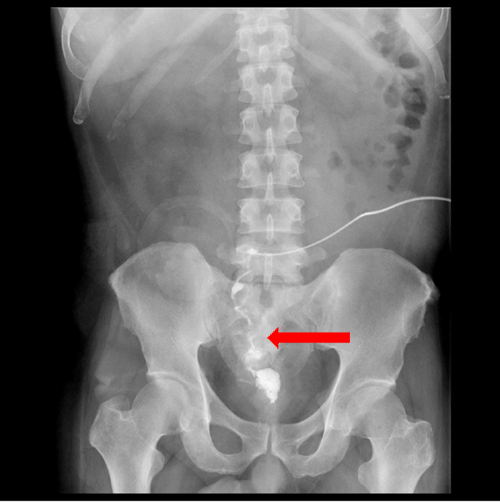Figure 2. Rectal Contrast study showing obliteration of fistulous tract.
The patient demonstrated continence following rectal contrast. The ileostomy was closed two weeks later. The patient is currently on follow-up; his stool frequency is 8 to 10 times per day, he is continent, and there is no recurrence of the fistula.
Discussion
Hindgut fistulae have been treated by several nonoperative techniques; these include endoscopic and percutaneous techniques using metal clips,5 gel foam,6 fibrin glue,7 and cyanoacrylate glue.8 Gel foam and fibrin glue lack the tensile and adhesive strength that cyanoacrylates provide. Fibrin glue, being an animal protein, may be associated with problems of allergy and prion disease transmission. The compound may also be broken down by enzyme-rich fluid secreted in the gastrointestinal tract.9 Cyanoacrylates are a class of synthetic glues applied as monomers, which polymerize in an exothermic reaction when in contact with a weak base such as water and blood.10 They solidify within the tract and induce an inflammatory response that enhances fibrosis and foreign body granuloma formation with ultimate epithelization.11 They are also significantly cheaper than the other agents. A potential complication of glue is the possibility of gluing a delivery catheter into the tract. This can be avoided by stopping the injection and withdrawing the catheter when the glue approaches the catheter tip. The use of hydrophilic catheters has reduced the risk of adhesion.12 Cyanoacrylate glue may be mixed with lipiodol, an oily contrast agent, before injection; this slows the rate of solidification, thereby reducing the risk of inadvertent adherence to catheters endoscopes. It also allows for visualization of the injected glue. Various ratios of glue and lipiodol are used, ranging from 1:1 to 1:1.6.10 In the present case, hydrophilic catheters or lipiodol were not used due to severe financial constraints, but it may be desirable to use them to ease administration. In a study of percutaneous injection of fistulous tracts with cyanoacrylate and lipiodol, six patients with a total of seven postoperative low-output enterocutaneous fistulas (ECF) of the large intestine were treated. Complete closure of all seven fistulas was achieved.13 In another series where endoscopic injection was done in seven ECFs, closure was achieved in all cases. However, 30 percent patients required two or more sittings.8 Two cases of pouch fistulae were treated with an endoscopic injection of the tract under fluoroscopic guidance using fibrin glue. Both were successful with no recurrence of the fistula after 12 months.14 The present case is the first reported closure of a pouch fistula using cyanoacrylate injection through a percutaneous route.
Conclusion
The present case demonstrates that cyanoacrylate glue can be used effectively as a low-cost and nonoperative method of achieving closure of simple fistulae following pouch leaks. Its utility in more complex fistula remains to be determined.
Lessons Learned
Redo surgery for pouch failure is a daunting task and is associated with poor outcomes. Nonoperative techniques like cyanoacrylate glue injection may help in salvaging patients with pouch fistulae.
Authors
Jacob Mathew, MBBS, MS, MCh
Department of Surgical Gastroenterology and Liver Transplantation, VPS Lakeshore Hospital, Nettoor, Maradu PO, Kochi 682040, Kerala, India
Mahesh Subramanya Iyer, MBBS, MS, DNB
Department of Surgical Gastroenterology and Liver Transplantation, VPS Lakeshore Hospital, Nettoor, Maradu PO, Kochi 682040, Kerala, India
Roy Mukkada, MBBS, MD, DNB
Department of Medical Gastroenterology, VPS Lakeshore Hospital, Nettoor, Maradu PO, Kochi 682040, Kerala, India
Hariharan Ramesh, MBBS, MS, MCh, FACS, FRCS
Department of Surgical Gastroenterology and Liver Transplantation, VPS Lakeshore Hospital, Nettoor, Maradu PO, Kochi 682040, Kerala, India
Correspondence
Dr. Jacob Mathew
Department of Surgical Gastroenterology and Liver Transplantation
VPS Lakeshore Hospital
Nettoor
Maradu PO
Kochi 682040
Kerala, India
Email :drjacobmathew@gmail.com
Phone : +919526971696
Disclosure Statement
The authors have no conflicts of interest to disclose.
References
- Fazio VW, Kiran RP, Remzi FH, et al. Ileal Pouch Anal Anastomosis Analysis of Outcome and Quality of Life in 3707 Patients Victor Warren. Ann Surg. 2013;257(4):679-685. doi:10.1097/SLA.0b013e31827d99a2.
- Lovegrove RE, Heriot AG, Constantinides V, et al. Meta-analysis of short-term and long-term outcomes of J, W and S ileal reservoirs for restorative proctocolectomy. Color Dis. 2007;9(4):310-320. doi:10.1111/j.1463-1318.2006.01093.x.
- Michelassi F, Lee J, Rubin M, et al. Long-term functional results after ileal pouch anal restorative proctocolectomy for ulcerative colitis: a prospective observational study. Ann Surg. 2003;238(3):433-41-5. doi:10.1097/01.sla.0000086658.60555.ea.
- Johnson PM, O'Connor BI, Cohen Z, McLeod RS. Pouch-Vaginal Fistula After Ileal Pouch-Anal Anastomosis: Treatment and Outcomes. Dis Colon Rectum. 2005;48(6):1249-1253. doi:10.1007/s10350-004-0872-9.
- Kumar R, Naik S, Tiwari N, Sharma S, Varsheney S, Pruthi HS. Endoscopic Closure of Fecal Colo-cutaneous Fistula by Using Metal Clips. Surg Laparosc Endosc Percutan Tech. 2007;17(5):447-451. doi:10.1097/SLE.0b013e3180dc9392.
- Lisle DA, Hunter JC, Pollard CW, Borrowdale RC. Percutaneous Gelfoam Embolization of Chronic Enterocutaneous Fistulas: Report of Three Cases. Dis Colon Rectum. 2007;50(2):251-256. doi:10.1007/s10350-006-0772-2.
- Hwang T-L, Chen M-F. Randomized trial of fibrin tissue glue for low output enterocutaneous fistula. Br J Surg. 1996;83(1):112-112. doi:10.1002/bjs.1800830135.
- Billi P, Alberani A, Baroncini D, et al. Management of Gastrointestinal Fistulas with N-2-Butyl-Cyanoacrylate. Endoscopy. 1998;30(6):S 69-S 69. doi:10.1055/s-2007-1001352.
- Bège T, Emungania O, Vitton V, et al. An endoscopic strategy for management of anastomotic complications from bariatric surgery: a prospective study. Gastrointest Endosc. 2011;73(2):238-244. doi:10.1016/J.GIE.2010.10.010.
- Seewald S, Sriram PVJ, Naga M, et al. Cyanoacrylate glue in gastric variceal bleeding. Endoscopy. 2002;34(11):926-932. doi:10.1055/s-2002-35312.
- Willetts IE, Dudley NE, Tam PKH. Endoscopic treatment of recurrent tracheo-oesophageal fistulae: long-term results. Pediatr Surg Int. 1998;13(4):256-258. doi:10.1007/s003830050310.
- Mathis JM, Evans AJ, Denardo AJ, et al. Hydrophilic Coatings Diminish Adhesion of Glue to Catheter: An In Vitro Simulation of NBCA Embolization. AJNR Am J Neuroradiol. 1997;18:1087-1091. http://www.ajnr.org/content/ajnr/18/6/1087.full.pdf. Accessed December 12, 2017.
- Sapunar LC, Sekovski B, Matic D, Tripkovic A, Grandic L, Družijanic N. Percutaneous embolization of persistent low-output enterocutaneous fistulas. Eur Radiol. 2012;22(9):1991-1997. doi:10.1007/s00330-012-2461-y.
- Lamont JP, Hooker G, Espenschied JR, Lichliter WE, Franko E. Closure of proximal colorectal fistulas using fibrin sealant. Am Surg. 2002;68(7):615-618. http://www.ncbi.nlm.nih.gov/pubmed/12132744. Accessed December 13, 2017.


